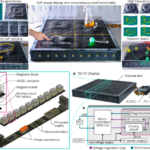2023-07-11 英国・ロンドン大学・クィーンメアリー(QMUL)

・ QMUL が 加わる力や変形を感知する優れた機能を有しながら、柔らかな状態と硬い状態の間をシームレスに移行するアクチュエーターを開発。
・ フレキシブルな材料によるロボットの能力を自己センシング機能で高めることは、真にバイオニックなインテリジェンスに向けた進展を意味する。
・ 自然な筋肉のような柔軟性と伸縮性を示し、複雑なソフトロボティックシステムへの導入と多様な形状への適応に最適となる。ストライプ構造で縦方向への 200%を超える伸縮能力に加え、非常に優れた耐久性を有する。
・ 電圧を変えることで硬さを急速に変化させ、30 回を超えて硬度を連続的に調整する。このような電圧駆動は、他の人工筋肉に比べ応答速度において大きな利点を提供する。
・ また、電気抵抗の変化により変形をモニタリングできるため、センサーの追加が不要となり、制御機能を簡易化しコストを低減させる。
・ 新アクチュエーターは、ソフトな金属メッシュで作製したアノードと薄膜カソード(センサー部として機)の間にアクチュエーション層を挟んだ構造で、簡易で高信頼性の製造プロセスで作製できる。
・ 薄膜カソードは、超音波拡散技術を利用してカーボンナノチューブを液体シリコーンと混合し、フィルムアプリケーターを用いた均一なコーティングを通じて作製する。液体材料の硬化後、自己センシング機能を備えた可変剛性人工筋肉が完成する。
・ ソフトロボティクスから医療分野まで広範囲のアプリケーションが可能。人間の身体へのシームレスな統合により、日常的なタスク実行において個人の支援に役立てられる可能性もある。
・ また、ウェアラブルロボティックデバイスに使用することで、患者の活動のモニタリングや、硬さの度合いの調整により抵抗力を付与し、リハビリでの筋肉機能回復の促進にも貢献できる。
・ 実用での課題は残るが、新技術は未来のソフト/ウェアラブルロボット開発の青写真を提供し、ヒューマン・マシーン・インテグレーションに向けた重要な進展を示すもの。
URL: https://www.qmul.ac.uk/media/news/2023/se/revolutionary-self-sensing-electric-artificial-muscles–.html
<NEDO海外技術情報より>
関連情報
Advanced Intelligent Systems 掲載論文(フルテキスト)
An Electric Self-Sensing and Variable-Stiffness Artificial Muscle
URL: https://onlinelibrary.wiley.com/doi/10.1002/aisy.202300131
Abstract
Soft robots have better flexibility than their rigid counterparts thus offering greater adaptability to changing environments. These robots made from flexible materials are generally with low stiffness and have limited capability to perform tasks that require the application of large forces. Soft artificial muscles (AMs) with variable stiffness are promising solutions for soft robots to handle larger payloads. However, the existing actuators need to overcome their small range of stiffness variation and slow response. Further, it is difficult to integrate self-sensing into existing actuators. Herein, a novel electric AM with variable stiffness and self-sensing referencing smooth muscle contraction in nature is proposed. The AM consists of two pieces of soft anode mesh, a flexible cathode and a polyvinyl chloride (PVC) gel dielectric layer, where the cathode is also a resistive sensor. The stiffness variation is induced by the friction change caused by electrostatic adsorption. Compared with the existing PVC gel actuation technology, the new design integrated the dielectric and the cathode layers and combined the sensing function. Also, the rigid anode and cathode are replaced by the soft ones, respectively, which makes the AM suitable for soft robotics or wearable devices.



